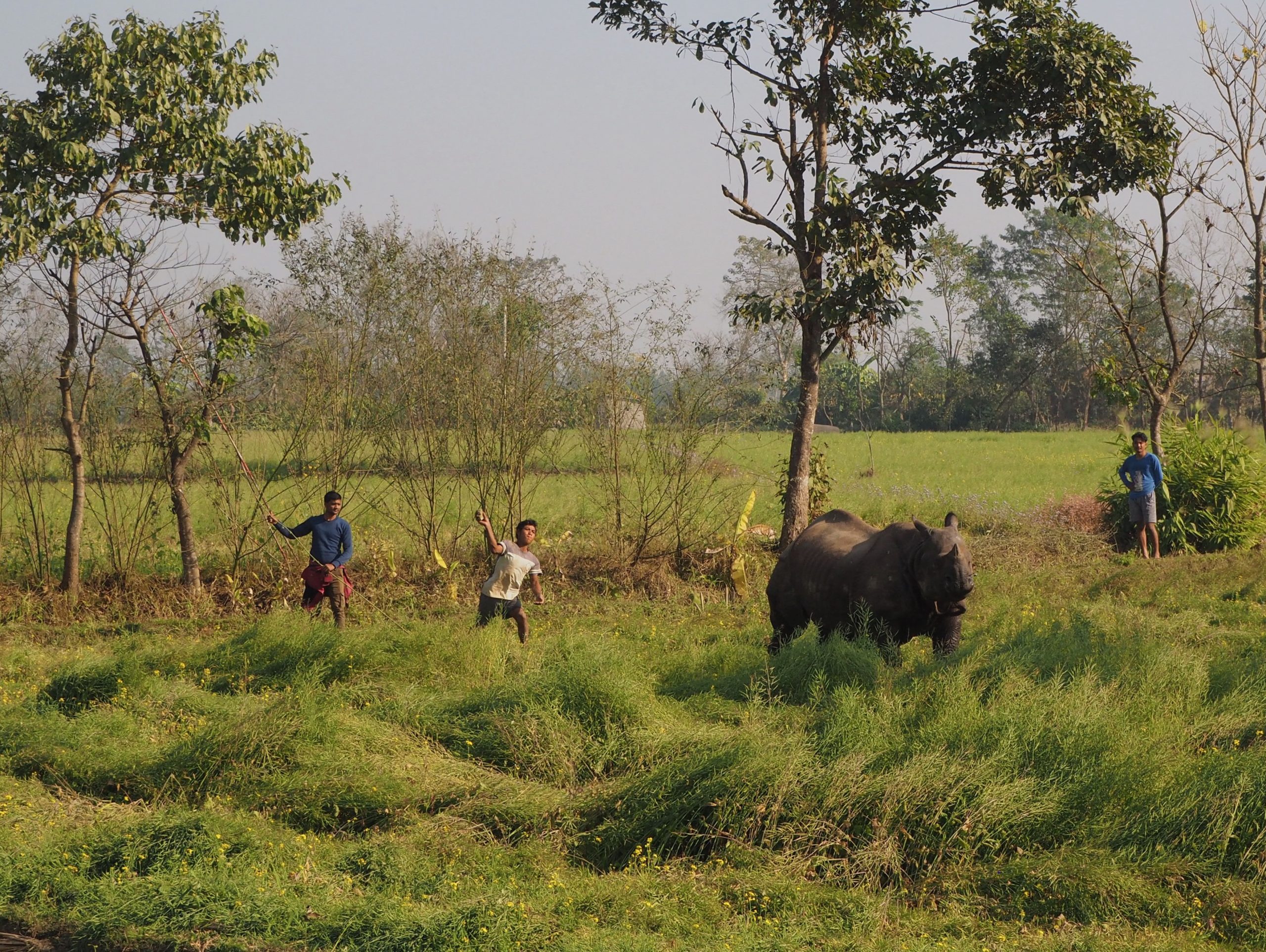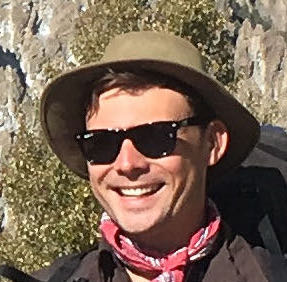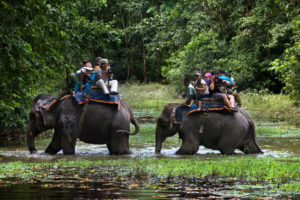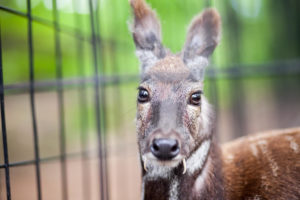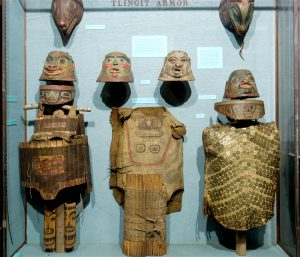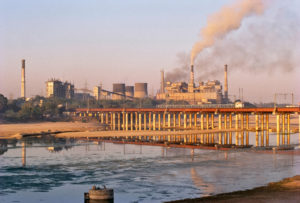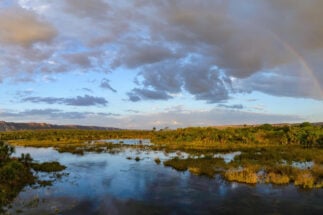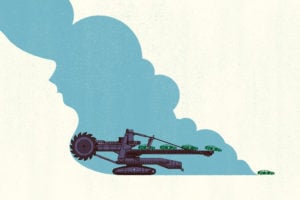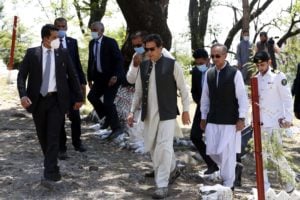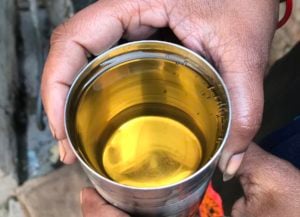On a sunny afternoon in January 2021, a male rhinoceros lumbered through intensively farmed land in Bachhauli, a village outside Chitwan National Park in Nepal’s Terai plains. Eschewing a patch of potatoes, he turned his attention to a field of buckwheat, munching on the bright pink blossoms before plopping himself into an irrigation canal to wallow in the cool, slow-flowing water.
Get the whole picture
This is one in a series of articles exploring some of the ways communities and governments in Asia are responding to the biodiversity crisis. You can view the whole series here
Worriedly watching the animal from a safe distance, Ramesh Pathak, a tall farmer with green eyes, used his mobile phone to call a game scout from the park. “He’s back again. When can you come?” Pathak asked. The rhino had grazed on Pathak’s crops several days in a row, and he was desperate for help in chasing the animal away.
By the time the game scout, Raj Kishor Sah, arrived, the rhino was back in the buckwheat field. Sah cut a long, thin switch of bamboo and, with Pathak and his neighbours, began herding the rhino in the direction of the park.
At first, the rhino charged the men. But he eventually resigned himself to his fate, sauntering jungle-ward along Bachhauli’s main road. The pachyderm passed within a few metres of homes, shops, a nervous pani puri street food vendor and a school bus full of cheering children. A little white dog barked incessantly, as if scolding the awesome, prehistoric-looking creature for trespassing into its owners’ modern world. The giant beast looked pitiable.
Chitwan National Park has had a number of conservation achievements. Before it was established, in 1973, widespread poaching had reduced the rhino population to a nadir of around 150 individuals in Chitwan. The park gave the animals protection, and despite increased poaching during the 1996-2006 civil war, Nepal recently grabbed world headlines when the latest rhino census counted more than 750 individuals. Wild elephants, gharial crocodiles and tigers have also made remarkable comebacks. In 2018, the government announced that Nepal’s tiger population had reached 235, nearly double what it had been in 2009, earning park authorities international plaudits.
Chitwan National Park’s wildlife makes it one of South Asia’s premier tourist destinations. When I was growing up in Kathmandu in the 1990s and early 2000s, I visited the Unesco World Heritage Site several times with my parents. In jeeps and on elephant-back, we were navigated through the park’s jungles and grasslands by naturalist guides who, in hushed voices, pointed out sambar deer, peacocks and rhinos. I always kept my eyes trained on the horizon for an ever-elusive tiger.
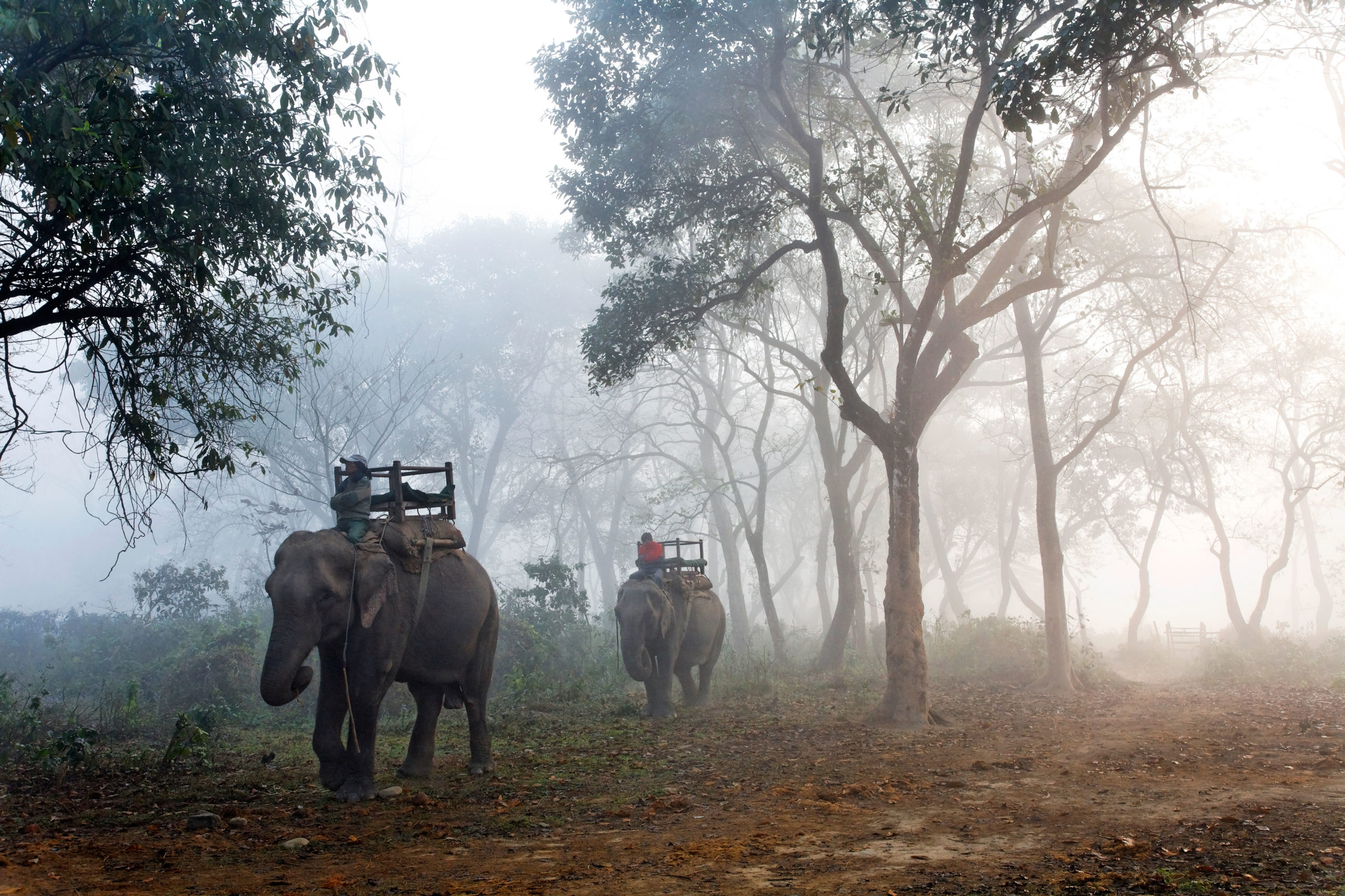
Years later, as an adult journalist, I began visiting Chitwan again. But instead of entering the park, I spent most of my time with the communities outside. I learnt that the park – like many others throughout South Asia – is a contested space. Important conservation gains have come hand-in-hand with benefits but also problems for local people, especially indigenous groups like the Tharu and Bote, thousands of whom were displaced from their homes to create the park.
Fifty years on, they face arrest, or worse, if they enter the park without permission. Park authorities and military guards are periodically accused of human rights violations. The park has brought jobs through tourism and funding through a community revenue-sharing mechanism, but high-caste, wealthier people, often originating from elsewhere in the country, control many of these benefits. Meanwhile, poor farmers face difficulties in obtaining compensation for wildlife damages, and my investigation indicates that the park undercounts the number of people killed each year by animals.
Activists and some progressive conservationists are calling for reforms, but park authorities insist the rebound of wildlife is proof positive that their approach is working.
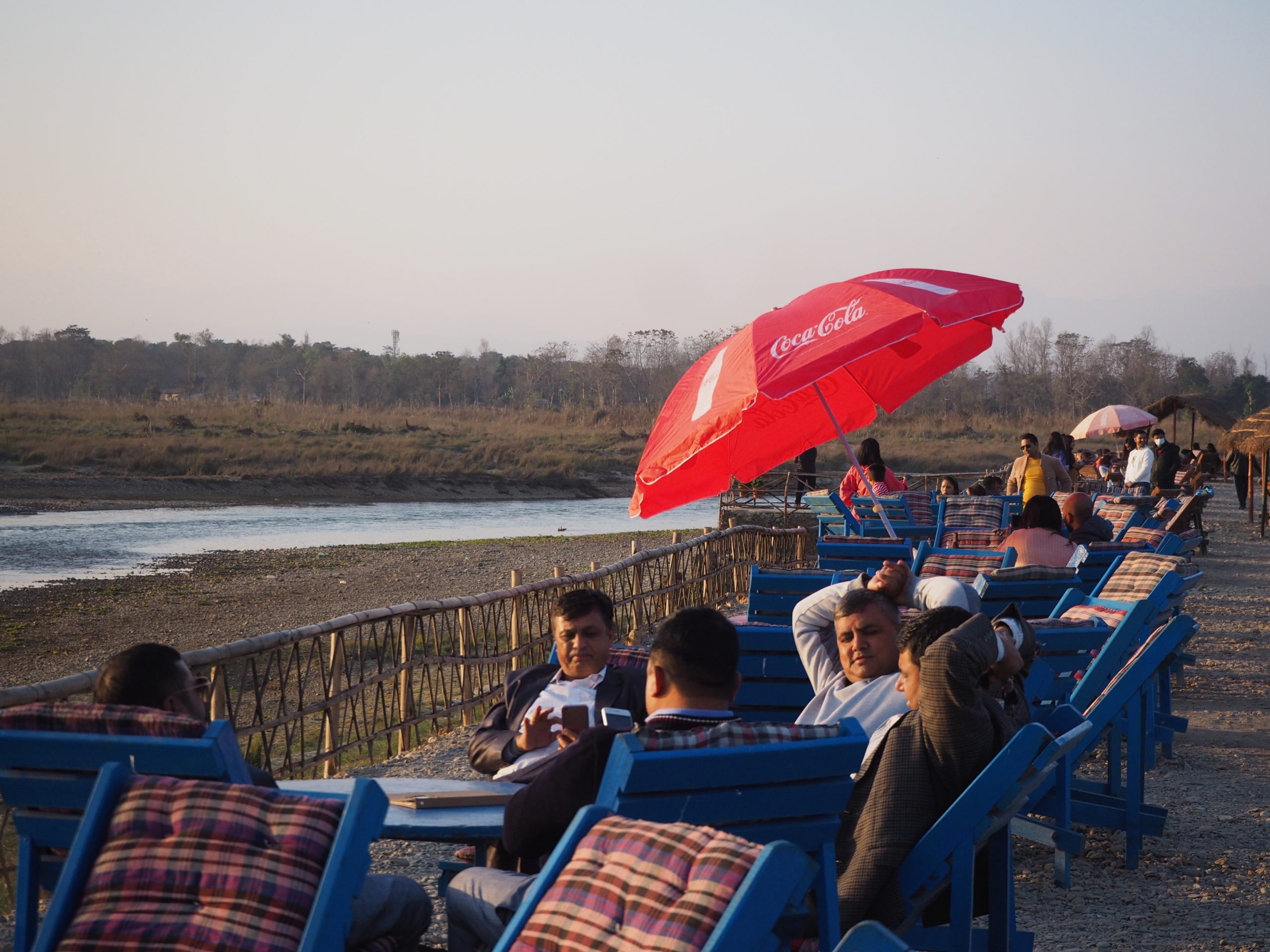
The fortress
Just before sunset one evening in February, I stood on the bank of the Rapti River, which forms the northern boundary of Chitwan National Park, and watched the arrest of a dozen local women. They teetered under unwieldy loads of grass as a group of soldiers marched them across the river, the hems of their hiked-up kurta suruwals dragging in the cold, blue water.
The women had been gathering fodder inside the park for their goats and other animals – an infraction against its bylaws. Rangers took the women to a nearby ranger post for detention until their family members arrived several hours later to pay the fines their grass-cutting had incurred.
The Nepali state has long sought to control access to Chitwan’s forests. Before it became a park, the area was an elite hunting ground for Nepal’s autocratic leaders, who sought to preserve game for sport. The Ranas, oligarchs who ruled from 1846 to 1951, periodically hosted big-game hunts, sometimes with prestigious foreign visitors, including Austrian Archduke Franz Ferdinand, Indian Viceroy George Curzon and the English King George V. The Ranas and their guests shot hundreds of tigers, rhinos and bears. The Shah monarchs, who ruled before and after the Ranas, continued the hunting tradition for a time; as late as 1981 King Birendra shot a rhino in Chitwan.
During the 1950s and early 1960s, studies by the International Union for the Conservation of Nature (IUCN) and the UK-based Fauna Preservation Society raised the alarm about dwindling wildlife numbers, which they attributed to habitat encroachment and illegal poaching. In response, the government initiated anti-poaching patrols in the 1950s and in 1973 established Chitwan National Park, covering the southern half of Chitwan district.
At the time the park was established, Nepali conservationists and their western advisers believed in the “fortress model” for parks: wildlife could be saved only by keeping local people out. The government used the army to displace 13 villages from inside the new park, many of them from the indigenous Tharu ethnic group.
Joanne McClean, a researcher from Charles Sturt University in Australia, interviewed Tharus about the removal of their villages. She wrote that “fields and houses were trampled by elephants” and soldiers threatened “men, women and children… sometimes at gunpoint”. With exceptions for tourists, who were allowed to take safaris and stay at park resorts (all of which were removed from the park interior in 2012), and besides three weeks each year when locals were allowed inside to cut elephant grass (a traditional Tharu building material), the fortress model prevailed.
Shift to communities as custodians
By the late 1980s, approaches to conservation were beginning to change in Nepal – at least outside of Chitwan. Large swaths of government forest in Nepal’s hills had been denuded as officials turned a blind eye to villagers cutting trees, or colluded with commercial loggers to illegally exploit timber. To combat deforestation, the government decided to try a novel approach: handing over management of degraded forests to community committees, which would enforce rules for their sustainable use. Giving local people a sense of ownership over resources, it was believed, would make them responsible custodians of the environment.
Community forestry, as it became known, was the polar opposite of Chitwan’s fortress model, and it worked – at least in ecological terms. Along with other factors such as outmigration, community forestry led Nepal’s forested area to nearly double between 1992 and 2016.
Inspired in part by the success of community forestry, in 1994 the Nepali government passed legislation to create “buffer zones” around national parks. In Chitwan, the forest department eventually handed more than 13,000 hectares of degraded land surrounding the park to communities to manage as “buffer zone community forests”.
At the same time, the park agreed to share with local communities 30% to 50% of revenue received from tourists. (This excludes budgets from the Ministry of Forests and Environment, charitable donations, and multilateral and bilateral donors like WWF, USAid and Unesco. In practice, the community share of tourism revenue has averaged 38% over the past 23 years.) All buffer zone spending must be approved by the park’s chief warden.
How much has really changed?
The creation of the buffer zone is sometimes portrayed as a transformation from the fortress model of conservation to one based on strong community participation. But there are legitimate questions about how much has really changed.
Communities do enjoy a limited role in decision-making over buffer zone community forests. These areas were largely treeless when they were handed over, and many of them have since been rejuvenated under community co-management, providing resources like firewood and fodder, and expanding habitat for wildlife. Community members have to buy a ticket (typically around 50 Nepali rupees, or USD 0.40) to enter community forests in the buffer zone, allowing the authorities to keep track of who is using which resources.
However, it is noteworthy that these forests were designated outside the park: the park gave up no territory of its own to create the buffer zone. In fact, when the buffer zone was being created in the 1990s, the park actually expanded, evicting thousands of mostly Tharu people from their homes in an area known as Padampur.
This is a world-renowned park. We need strict protection to keep it this way. If poachers are able to come into the park, then tigers are finished. Rhinos are finished.Ananath Baral, chief warden of Chitwan National Park
Meanwhile, local communities have no role in managing the park itself, and are not allowed to enter it either, save for what is now merely a three-day annual grass collection period (reduced from the original three weeks). With several battalions of the Nepal army deployed within its boundaries and park staff posted at checkpoints throughout the reserve, the park remains a highly militarised space.
One afternoon in February in Bharatpur, a city near the park, I interviewed Ananath Baral, Chitwan’s chief warden. His office has ultimate control over park management and security decisions; until 2017, the warden held the right to arrest anyone without a warrant and sentence suspects to imprisonment for up to 15 years, without judicial oversight.
Speaking confidently in a mix of Nepali and English, Baral told me that strictly patrolling the park remains his top priority. “This is a world-renowned park,” Baral said. “We need strict protection to keep it this way. If poachers are able to come into the park, then tigers are finished. Rhinos are finished.”
While poaching was a serious problem during the civil war in the early 2000s, it sharply declined over the following decades, in part due to stricter patrolling. The park has celebrated a number of “zero poaching years”. Meanwhile, other threats to endangered wildlife, such as highways, canals and other infrastructure being built through forests, have grown.
In their continuing efforts to keep local people out, park authorities and the army are periodically accused of human rights violations. In July 2020, a young man named Raj Kumar Chepang died after Nepali Army soldiers allegedly tortured him. Chepang had been detained for collecting freshwater snails – a delicacy favoured by indigenous groups – inside the park. The same month, according to an investigation by Amnesty International, park authorities destroyed a squatter settlement of landless Chepang indigenous people on the edge of the park, using domesticated elephants to tear down their shelters and setting two houses on fire.
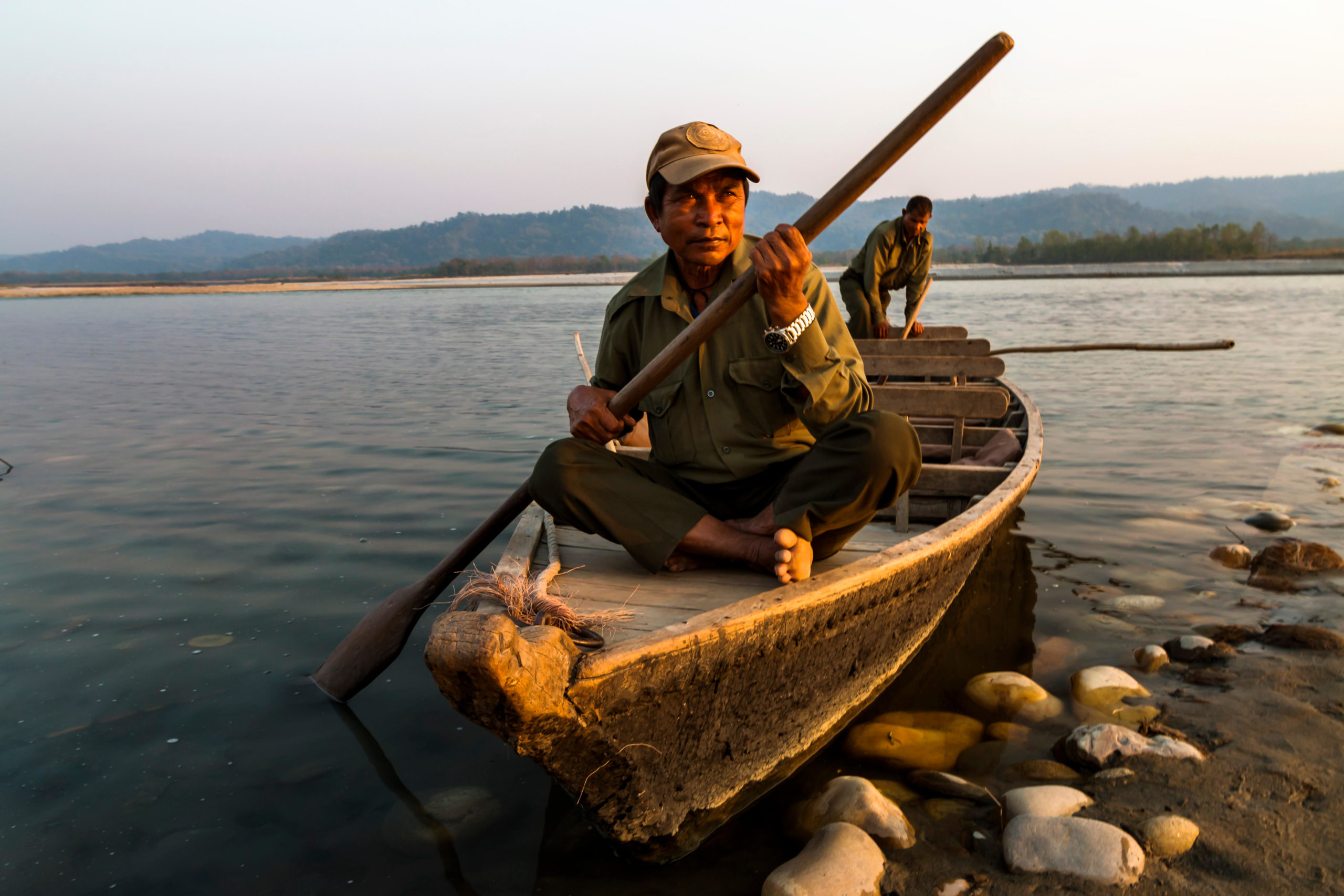
In a December 2020 letter to UN human rights experts, the Nepali government vehemently denied allegations of destroying Chepang homes in Chitwan. It claimed that authorities had simply “removed 8 Katha of maize crop, 9 wooden towers and 2 sheds from the area”. In the same letter, the government noted that it had arrested and is investigating Chiran Kumar Budha, a Nepali Army sergeant, for the murder of Raj Kumar Chepang.
But critics point out that the Nepali Army remains largely unreformed since the 10-year civil war, when it was accused (along with the Maoist rebels) of widespread human rights abuses. Until 2006, the army professed its loyalty to the crown, and some still question whether it is fully under civilian control.
I asked the Nepali Army to comment on the issues described in this report; a response had not been received at the time of publication.
Furthermore, international NGOs have been accused of turning a blind eye to injustices committed in the name of conservation. In 2019, The Kathmandu Post and BuzzFeed News jointly reported that the World Wide Fund for Nature (WWF) gave conservation awards and jobs to Chitwan park officials even after they were accused of torturing a man to death in 2006. In 2020, an independent investigation issued a report critical of WWF’s human rights record, not only in Nepal, but also elsewhere in South Asia and Africa.
Chief warden Baral – who himself received financial support from WWF for a master’s degree in New Zealand – dismissed human rights concerns as overblown.
“The army are very disciplined – very disciplined,” he said. Baral declined to discuss the case of Raj Kumar Chepang, noting that he was not yet chief warden and was posted at another national park at the time. However, regarding the destruction of the indigenous squatter settlement last summer, he said: “The human rights activists were just looking for something to complain about. What really happened was the people were encroaching on park land. It doesn’t matter their caste or ethnicity – what is important is they were encroaching.”
Who benefits?
For those able to adapt, the park has unquestionably provided opportunities.
Though he is semi-retired, on weekends Bishnu Lama sells tickets at the National Trust for Nature Conservation wildlife museum in Sauraha, a tourist town outside the park’s main gate. The space is replete with crocodile skins, elephant skulls, river dolphins floating in formaldehyde and other naturally deceased animals. Most visitors are unaware that Lama collected and taxidermied many of the specimens himself.
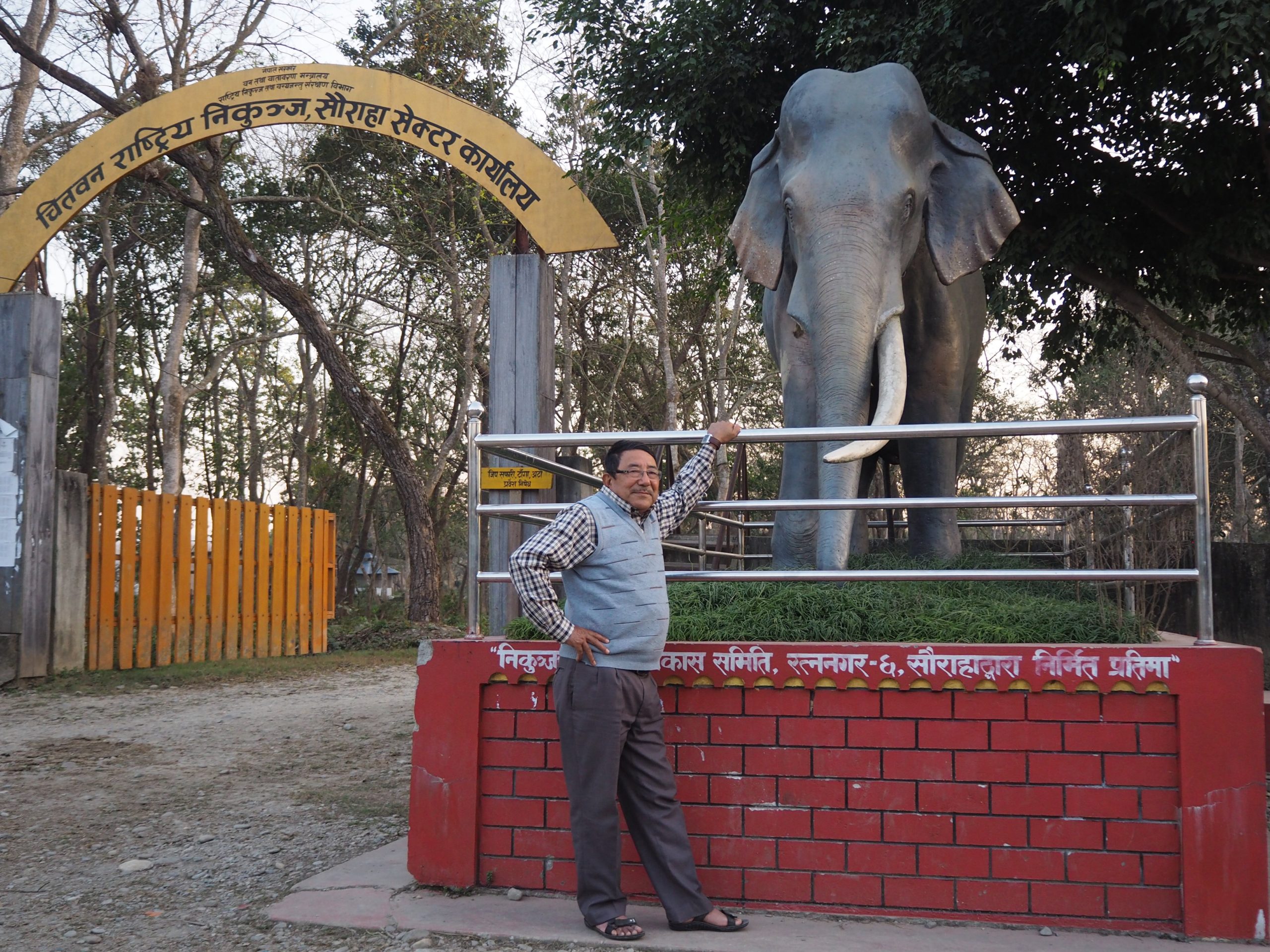
Lama was born in a poor village in the hills but migrated to Chitwan at age 18, landing a job with a wildlife census just prior to the park’s establishment. His own father had been a hunter, and Lama quickly became adept as a wildlife technician, darting and collaring tigers and other large animals for research and translocation.
In the 1980s, Lama was working for a visiting wildlife professor from the University of Minnesota when the two men and the professor’s infant son were attacked by a rhinoceros. The professor was gored but survived, while the boy – a close friend of mine – lived because Lama lifted him into a tree before fleeing to safety. Lama’s heroism sparked a long friendship between the two families, and Lama went on to work with the professor in Vietnam, Thailand and Bangladesh. Lama also worked for decades for the Trust, which, besides running the wildlife museum, implements many of Chitwan National Park’s research and conservation activities.
“If the park hadn’t been established, I don’t know where I would have ended up, because I didn’t have much formal schooling,” Lama told me. “I’ve had the opportunity to learn so much from local and foreign scientists.”
James L David Smith, the professor whose son survived the rhino attack thanks to Lama, told me that an expanding coterie of Nepali wildlife professionals have cut their teeth in Chitwan. “The Smithsonian [Institution in Washington DC], then WWF and then the US Fish and Wildlife Service have supported the Department of National Parks and the Trust. I have lost count, but I think there have been more than 15 Nepali PhDs and more than 20 MS degrees,” he said.
Wildlife tourism has also brought thousands of jobs to the area. A stone’s throw from the wildlife museum in Sauraha is a mushrooming strip of beer gardens, live-music restaurants and guesthouses – an important hub for local employment.
One January afternoon I had tea with Trailokya Chitrakar, the owner of the Royal Park Hotel, beneath a flame tree on the resort’s sprawling lawn. Chitrakar, who is originally from Kathmandu, employed 38 staff before business plummeted due to the Covid-19 pandemic. He said he is grateful for the park and donates some of his profits each year for conservation activities. “Other businesspeople here need to understand: without the park and wildlife, there is no tourism,” he said.
However, the park has not benefitted everyone equally.
Prior to the mid-20th century, malaria was endemic to Chitwan. This meant only a few indigenous groups, who had partial genetic resistance to the disease, could inhabit the area year-round. (Rana and royal hunting expeditions were confined to winter time, when mosquitoes were largely absent.) Groups indigenous to Chitwan included the Tharu, Bote, Darai, and Kumal. The largest group among them, the Tharu, farmed rice, herded cattle and collected various wild foods and materials from the forest and grasslands.
Some people call DDT ‘Deadly Dose for Tharu’, because so many of our people lost land after the spraying campaignBirendra Mahato, director of the Tharu Cultural Museum and Research Center in Sauraha
During the 1950s – prior to the park’s establishment – with assistance from the World Health Organization and what became the United States Agency for International Development (USAid), Nepal’s government launched a massive malaria-eradication campaign using DDT. By the early 1960s, the near-eradication of malaria allowed non-indigenous groups to permanently settle in the northern part of Chitwan district. The US, eager to outdo Soviet and Chinese aid to Nepal, went on to assist the Nepali government in a massive irrigation and resettlement scheme in Chitwan, which transformed the area into the country’s bread basket.
These projects also transformed Chitwan district’s demographics. According to historian Tom Robertson, who has studied American aid to Nepal, Chitwan’s population increased from 25,000 in 1955 to 125,000 by 1970, mostly due to an influx of migrants who descended from Nepal’s hills to claim plots of the area’s rich, alluvial soils. Because Tharus and the other indigenous groups were mostly illiterate and unfamiliar with government bureaucracy, many were pushed off agricultural land and pastures they had used for generations.
Squeezed by migrants from the hills on one side, indigenous groups ran up against conservationists on the other. When the park was created in 1973, some displaced people were provided land elsewhere as compensation. Once again, many indigenous people faced insurmountable bureaucratic hurdles in claiming land.
“Some people call DDT ‘Deadly Dose for Tharu’, because so many of our people lost land after the spraying campaign,” said Birendra Mahato, the director of the Tharu Cultural Museum and Research Center in Sauraha. “At the same time, Tharus lost land because of the park.”
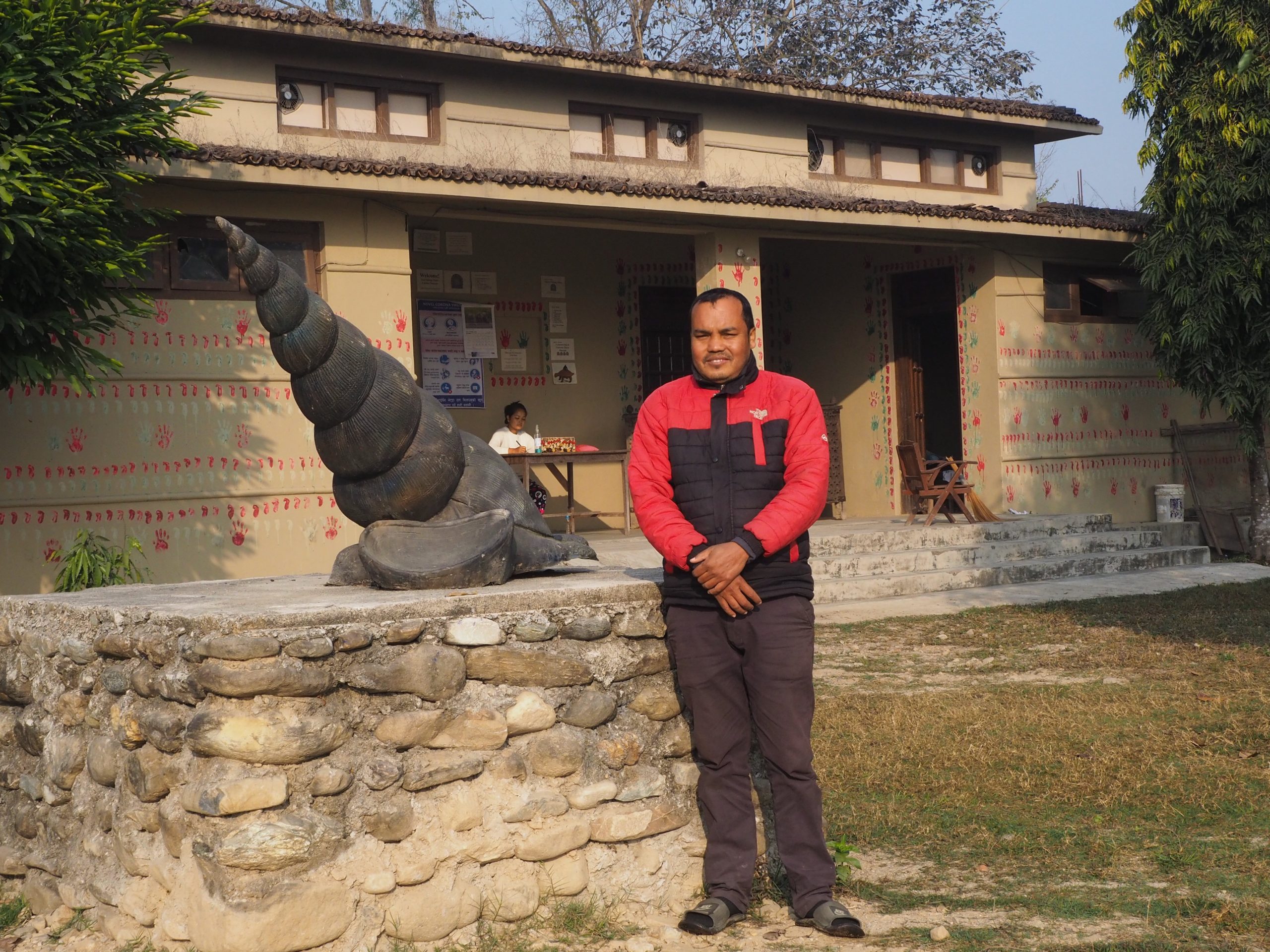
Today, the vast majority of hotels in Sauraha are owned by non-indigenous people. According to a database of the Regional Hotel Association Chitwan, there are just six indigenous owners or managers at Sauraha’s 93 hotels. Most of the rest come from high-caste hill-origin groups.
No voice, no power
Non-indigenous people also control most of the money that the park shares with communities. Buffer zone funds are managed by locally elected user committees, which carry out a variety of infrastructure projects, job skills training and conservation-related programmes. However, currently just three (14%) of the buffer zone central management committee’s 22 members are indigenous to Chitwan. This is despite the fact that indigenous people make up roughly one-third of the population in the 14 VDCs (administrative units) that fall completely within the buffer zone. All of the committee members are men.
We shouldn’t be treated like criminals because we’re indigenous, we are native to this place… we live here our whole livesLal Bahadur Bote, a Bote man
“Even though there are elections, the system is closed off to Tharus, because we don’t have political networks. It’s not full democracy,” said Mahato. As a result, “the budgets don’t go for Tharu priorities, like livelihood trainings specifically targeted for indigenous people.”
The Bote, an indigenous group who live along the banks of Chitwan’s rivers, have a particularly contentious relationship with the park. The Bote were traditionally fishers, but today the park restricts fishing in the waterways that form the boundaries of the park.
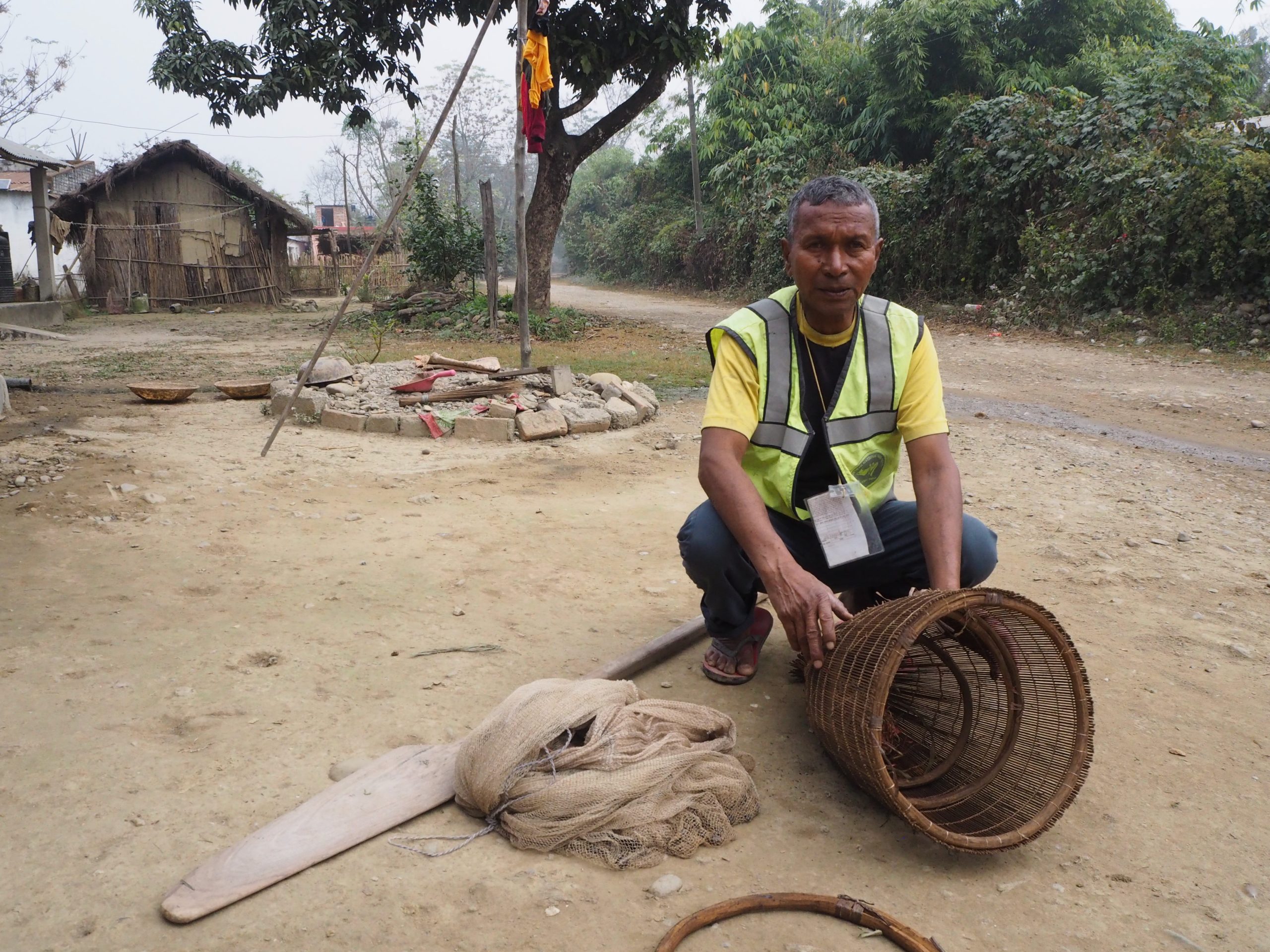
In November 2020, authorities arrested several dozen Bote men in their 20s and 30s who were picnicking on an island in the Narayani River, just inside the park boundary. Rangers destroyed the men’s boats, claiming they were unregistered, and sent the men to detention in Amaltari, a village in Nawalparasi district.
The rangers planned to transfer the detainees for further prosecution in Kasara, the park’s main headquarters, but before they could do so, a large crowd of Bote villagers gathered at their office to demand the men’s release. The agitated crowd broke down the office gate and freed the detainees by force. Eventually, the park agreed to settle the dispute by fining the men without pressing further charges.
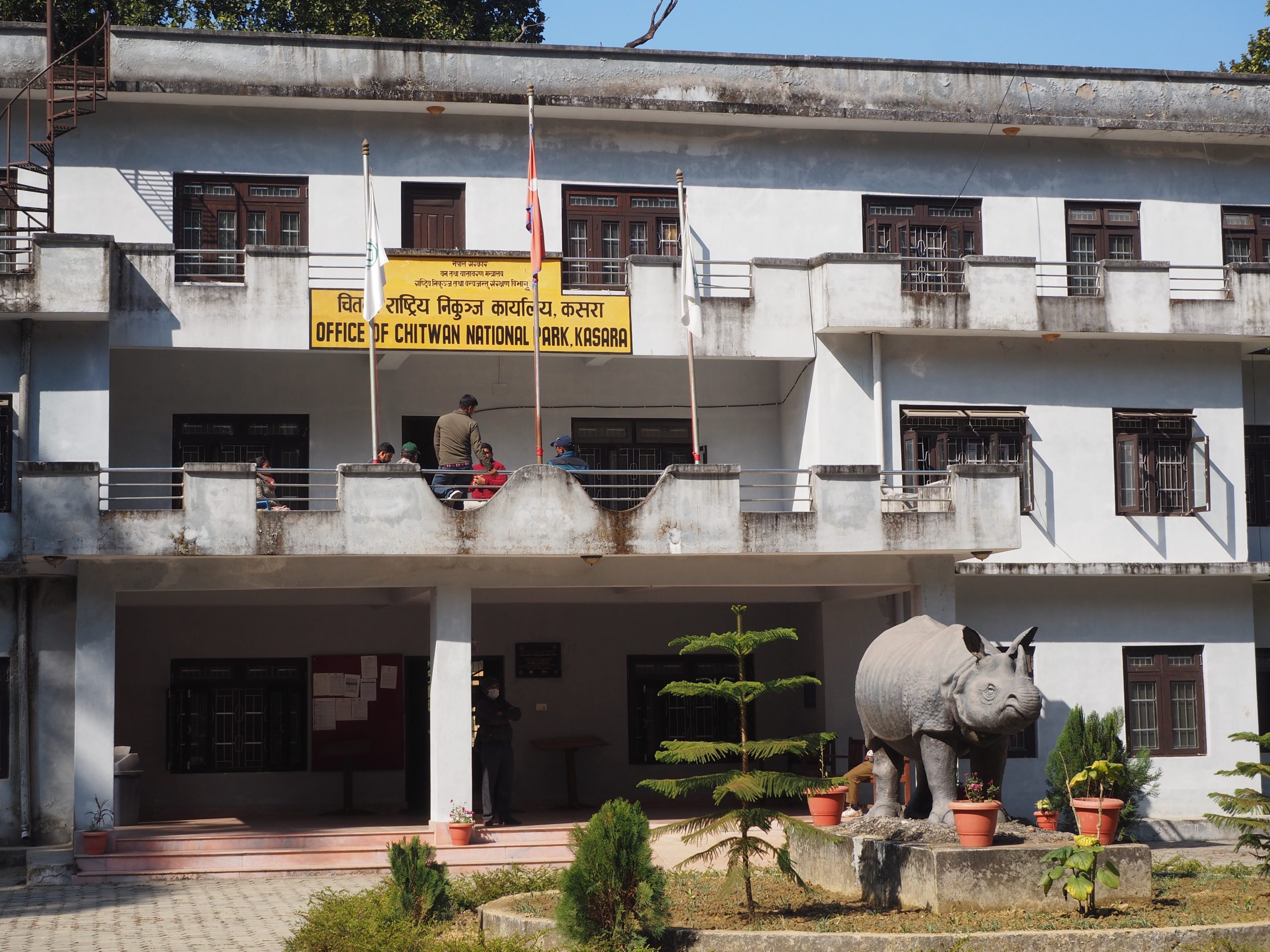
Lal Bahadur Bote, one of those arrested, told me the incident left him bitter. “Sure, we made a mistake by going for the picnic,” he said. “But we felt like we shouldn’t be treated like criminals because we’re indigenous, we are native to this place. The park authorities come for a year or two, then are transferred elsewhere. But we live here our whole lives, and we have more love for all the animals in the park than they do.”
Officially, the park allows 250 permit holders from indigenous groups to fish using traditional throw nets on the edges of the park. Unofficially, however, the programme is being phased out. Baral, the chief warden, told me he has stopped issuing fishing permits to new applicants or renewing permits that lapse – a practice that, if continued, will eventually end the right of indigenous people to fish in the reserve.
Baral believes that ending fishing is necessary to protect endangered riverine species. He told me, “How would we protect our river dolphins, our crocodiles, if there are no fish left for them to prey on? Instead of complaining about their rights, which NGOs encourage them to do, shouldn’t [indigenous people] be educating their children so that they can be doctors, pilots and policymakers?”
I put this argument to Gyan Bahadur Bote (no relation to Lal Bahadur), who owns a hotel in Amalatari village and is one of the few Bote who hold an advanced degree (a master’s in sociology). He was incredulous. “The park allows paper factories and alcohol distilleries to operate in the buffer zone, upstream from the park. They kill more fish by polluting the rivers,” said Gyan Bahadur. He said the park should continue to issue Bote communities fishing licences, while also helping them to pursue livelihoods in tourism and other sectors. “Bote are fishermen. Fishing is our identity. If we lose that, then who are we?”

Man versus wild
Simara village, located on the opposite side of the park to touristy Sauraha, feels far off the beaten track. Simara lies in Maadi Rural Municipality, a pocket of settlements surrounded by jungle that some Hindus believe to be the site of the ancient Pandav kingdom from the epic poem the Mahabharata. It is almost entirely Tharu and lacks electricity or a permanent road. When the nearby Rheu River swells during the monsoon it is inaccessible by vehicle.
Here, livelihoods are regularly disrupted by wildlife. One farmer, Bir Bahadur Chaudhary, told me that every year, wild elephants and boar destroy about one-third of his crops – a major loss for him, since he owns less than a quarter-hectare of land.
Another Simara resident, Khedu Mahato, was attacked by a rhino last year while collecting grass near his mud-and-wattle home. “I thought I would die,” he said. The animal shattered the bones in his forearm, and although the park paid his medical bills, Mahato can no longer work. He said he had applied for, but was yet to receive, a government disability allowance.

Just in the past month, two people have been killed by a tiger and a crocodile in the park. Residents, angry with the authorities’ handling of the tiger attack, reportedly vandalised a park office.
To reduce human-wildlife conflict (or HWC in conservationist parlance), the park has built scores of kilometres of concrete walls and fencing along boundaries where there are settlements. But completely sealing off the park is not a viable option: walls are expensive and block wildlife movement into buffer zones and habitat corridors. Experts believe habitat corridors are particularly important in saving endangered species from extinction because they allow populations from across the landscape to mix, stopping inbreeding.
Another approach to reducing HWC is to help people adopt new livelihoods that are less susceptible to predation from wild animals. NGOs have introduced various schemes, from fish farming and biogas plants to village homestays. But jobs in tourism, the most attractive alternative to farming, remain concentrated in a few towns and are often inaccessible for indigenous people.
Compensation flaws
Many countries around the world provide safety nets for victims of HWC. Ranchers in the western US, for example, can claim reimbursement for cattle killed by wolves, and the WWF has helped initiate subsidised livestock insurance programmes in various developing countries.
In Chitwan, villagers can apply to the park for compensation for damage to crops, livestock and homes, and for human deaths caused by wildlife. However, compensation is often incomplete. Currently, farmers may claim a maximum of 10,000 Nepali rupees (about USD 84) per damaged crop or up to Rs 30,000 for preyed-upon water buffalo or oxen. In many cases, this is just a fraction of the actual loss; experts in HWC at Chitwan told me an adult water buffalo fetches up to Rs 100,000 at point of sale. Certain types of crops, such as vegetables, are ineligible for any compensation.
Moreover, the compensation application process itself can be arduous. Victims need a bank account as well as signatures from up to four different government offices. Several farmers told me that after submitting their applications, they waited nearly a year before receiving compensation. The combination of low compensation amount, bureaucracy and long wait discourages some farmers from applying at all. Those who do apply tend to be from high-caste hill-origin groups; in the 2018-19 fiscal year, just four out of 100 crop compensation recipients were indigenous to Chitwan.
2/3 deaths not recorded
Data reveals that two-thirds of deaths due to wildlife in Chitwan’s Mrigakunja buffer zone user group were not documented by the park in the past five years
Baral, the chief warden, said that his office does the best it can. “We have to do site checks and verify all their [applicants’] documents. Our human resources are limited, and our people are running around doing this – it costs their time, and fuel.”
In 2018-19, HWC compensation payments in Chitwan totalled just 6% of the park’s revenue from tourism. Baral said the international community should share more of the burden. “If a tiger injures someone, who should compensate that person? The tiger is not my property, or Nepal’s property – it’s global property,” he said.
The animals most dangerous to people are rhinos, elephants, tigers, and, to a lesser extent, crocodiles and bears. The park uses various methods to address “problem animals”. Tigers who develop a taste for human blood are sometimes relegated to captivity in Jawalakhel Zoo in Patan, near Kathmandu. Aggressive wild elephants can be collared with radio transmitters to track their movements, although this doesn’t always prevent casualties. While I was in Sauraha in January, a wild elephant named Ronaldo, which has killed many people and wears a radio collar, destroyed a local family’s home. Families of the deceased are eligible for Rs 1,000,000 (USD 8,400, an increase from USD 4,800 in 2017 and just USD 2,000 in 2012).
If a tiger injures someone, who should compensate that person? The tiger is not my property, or Nepal’s property – it’s global property.Ananath Baral, chief warden of Chitwan National Park
According to official park reports, 44 people were killed by wildlife in Chitwan between 2015 and 2019. While often parroted by the media, the official statistics may significantly undercount human deaths because park authorities only report the deaths for which they have provided compensation. Many people who are killed by wildlife are ineligible for compensation, either because they entered the park illegally or because they entered a buffer zone forest without buying a ticket first. When I asked park officials about non-compensable deaths, they initially claimed to keep unpublished records before telling me that they do not have them.
Most buffer zone user groups also fail to record non-compensable deaths, except for one group in Mrigakunja, an area that includes Sauraha. Ram Krishna Parajuli, the office secretary, told me that he records all deaths so that he can connect victims’ families with tourists or other donors, who are sometimes willing to aid them. Parajuli’s data – which I verified – reveals that over the past five years, the families of only three of the nine people killed by wildlife in Mrigakunja were compensated; two-thirds of deaths went undocumented by the park.
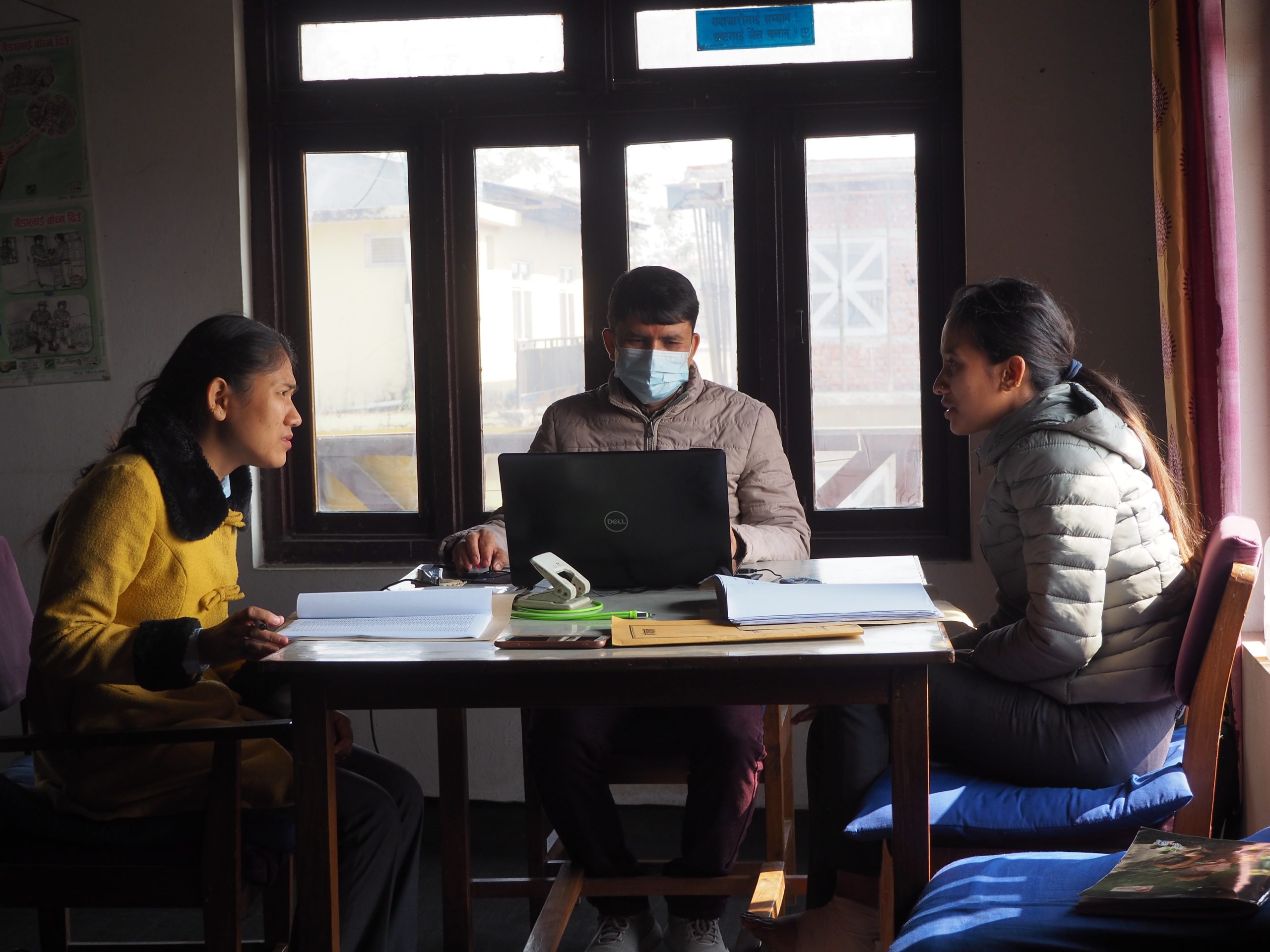
Maya Tamang Jhankri was typical of the uncompensated Mrigakunja victims. She walked into the park to collect fodder for her goats on 12 January, 2021, when a rhinoceros in the high grass charged and killed her. Jhankri left behind three children, two of them young. Her widower, Singha Bahadur, told me Maya had gone to the park rather than the community forest, which is closer, because the latter does not have enough fodder. “Everyone knows the law that we’re not allowed to go in the park,” he said. “But it’s a compulsion. We’re landless, and we’ve got to feed our goats.”
Various park and donor-funded programmes claim to reduce HWC through alternative livelihood programmes for people like Maya Tamang Jhankri, by helping them become less dependent on forest resources. The USD 57 million USAid-funded Hariyo Ban (‘Green Forests’) project (phases I and II), for example, implemented various skills training and small business support between 2011 and 2020. However, despite periodically surveying beneficiaries about their perceptions, the project lacked hard data to monitor HWC.
Babu Ram Lamichhane, a biologist in charge of HWC-related programmes at the National Trust for Nature Conservation, told me that it is important to track human deaths, further reduce HWC, and perhaps provide partial compensation for trespassers.
“The park argues that if they compensate those victims, then it will encourage people to enter the park illegally. But personally, I’m for compensation,” he said. “Otherwise, families of victims may develop a negative view of the animals and could try to poison them. And that’s a loss for conservation.”
Towards reform
Chitwan is governed by the National Parks and Wildlife Conservation Act of 1973 and its own bylaws, first drafted in 1974. Many conservationists believe amendments or a complete overhaul of the statutes are overdue.
Haribhadra Acharya, spokesperson for the Department of National Parks and Wildlife Conservation, told me that the law needs to be updated to better regulate infrastructure development, manage encroachment by villagers, provide for community-based anti-poaching units, strengthen buffer zone user committees and allow for sustainable use of medicinal plants. However, he noted, “We cannot say [the law] will be amended soon as the process takes time and needs to be approved by Parliament.”
Indeed, until a new law is drafted, it remains unclear whether the government will seek to strengthen the role of local communities or take the opposite approach, further buttressing the park’s ramparts against them.
Jit Bahadur Tamang, the chairman of the Baghmara Community Forest, which is located in the buffer zone, told me that he wants community-friendly reforms. “Nepal’s park regulations and laws are already very strict. But how do you solve problems by just being strict? We need to address people’s needs.”
Shankar Limbu, an advocate at the Lawyers’ Association for Human Rights of Nepalese Indigenous Peoples, who has documented abuses by park authorities, was more blunt. “The park still views locals as criminals, as their enemy. This needs to change,” he said.
Limbu said the army should be removed and people from the local community hired to patrol the park (such patrols already exist in the buffer zone). “In many aspects, local people can take over self-management of the park. They have traditional knowledge that can make the park sustainable. When it was just indigenous people who lived in the area, the rhino population was much higher.” An estimated 800 rhinos – more than the current number – roamed Chitwan district in 1950, before the eradication of malaria and in-migration of hill groups.
Lamichhane, the biologist from the Trust, favours more cautious reform. “There is always going to be a need for balance,” he said. “Some communities have benefitted from the park, especially through tourism. But others have not benefitted, and have suffered harm. We need to continue to regularly support them. Compensation schemes are not enough. We need people to feel, ‘I have also benefitted from this park, and from conservation.’”
Not all of Nepal’s national parks face the same challenges in community relations as Chitwan. In Sagarmatha National Park in the Everest region, human rights abuses are much rarer, and the local indigenous community (the Sherpas) have profited greatly from tourism. But Sagarmatha’s successes would be difficult to replicate in Chitwan because of its different history. Sherpa villages were not removed when the park was created and poaching has always been less of a problem there.
In recent years, megafauna like tigers have been spotted in community forests far from Chitwan, including in the hills of Ilam and Palpa districts. Teri Allendorf, an American biologist, is working to equip community forest user groups there with the skills to track and manage wildlife.
“Nepal is this amazing global example of what probably needs to happen everywhere,” she told me. “You have 30% [of land area] being managed by communities. So in terms of biodiversity, you have so much more conservation going on because you’ve now included community forests, in terms of the landscape… I can see how people might not like the idea of PAs [protected areas like Chitwan Park], because why not let communities also manage them or co-manage? Sometimes strictly guarded PAs may be necessary to protect certain species or habitats. [But] this doesn’t preclude community participation in management.”
One sunny afternoon, a friend and I rode our motorbike into a clearing in the jungle north of the Rapti River, just outside Chitwan National Park. The buffer zone forest there was one of many handed over for community park co-management in the 1990s. Before us lay a wide oxbow lake. On the shore at the far end, a large, dark mass munched on reeds. For a moment, all was still and quiet. Then, with a loud whoosh, we saw that it was a rhinoceros, which had plunged into the lake, shattering the glassy water.
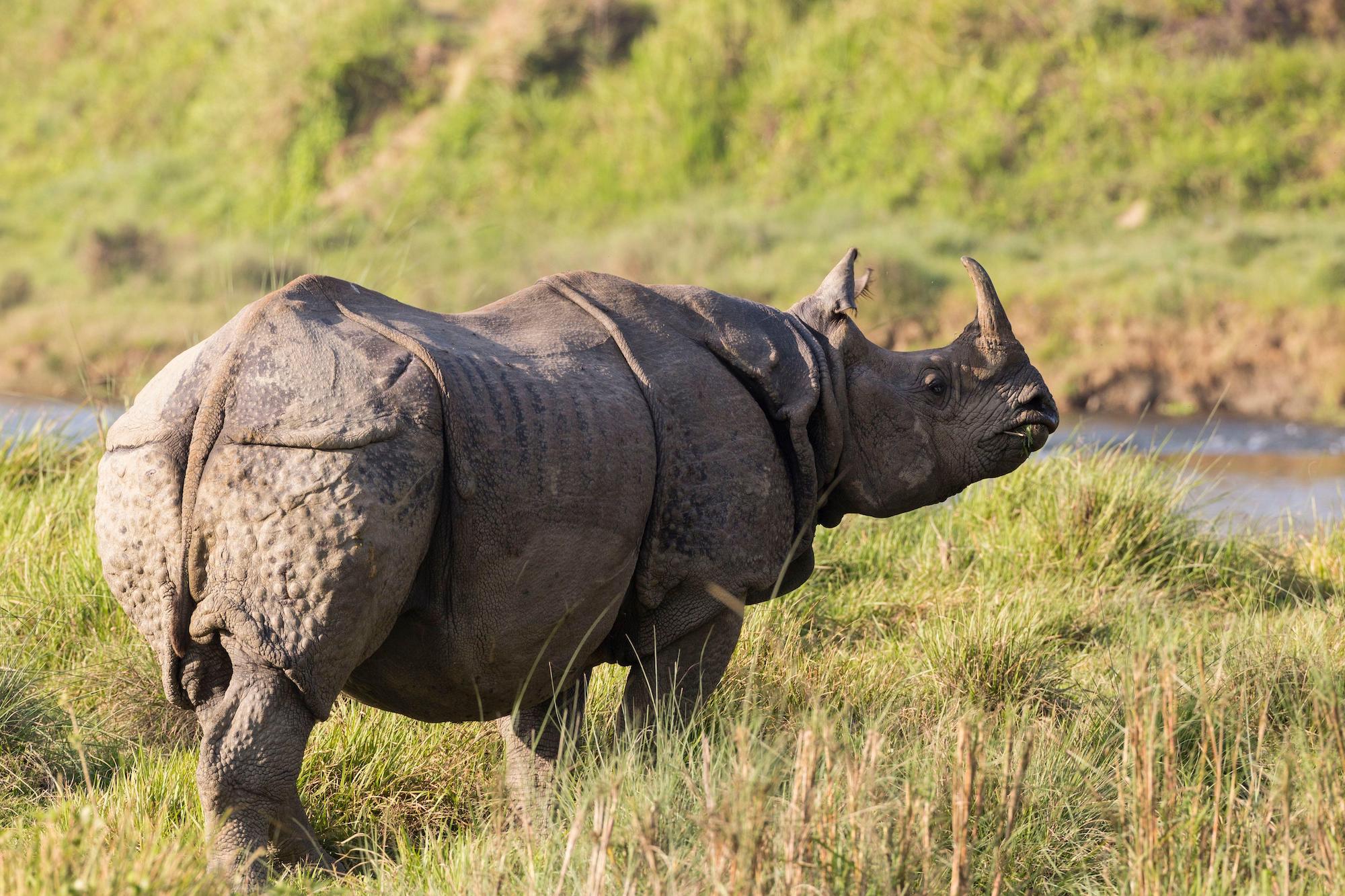
I thought of the rhinoceros I had seen a few weeks earlier in Bachhauli village, forlorn and alien-looking amidst the crowds and shops. By contrast, the beast in front of us now looked at peace and comfortable in its own environment.
Conservationists often remind us that we, as a species, are plundering the planet. We steal jungles from animals, rob rivers from fish, and inject carbon into the atmosphere, thus racking up a climate debt that future generations will have to pay.
Parks and other protected areas might be viewed as representing a modicum of compensation for our environmental banditry. Globally, this compensation is small compared with the scale of the harm we have caused, and importantly, we do not all pay it equally. Indeed, the communities forced to give up the most for conservation often have the least to atone for. Getting conservation right, it seems, will require confronting and addressing this truth.
My friend kicked the motorcycle back into life, and we drove on.
